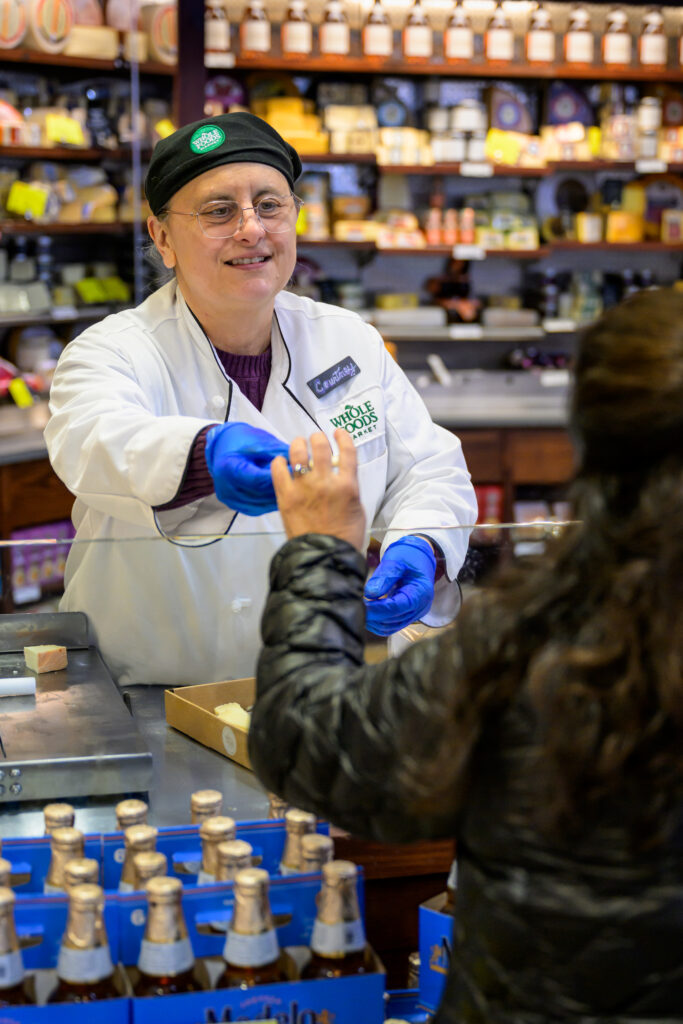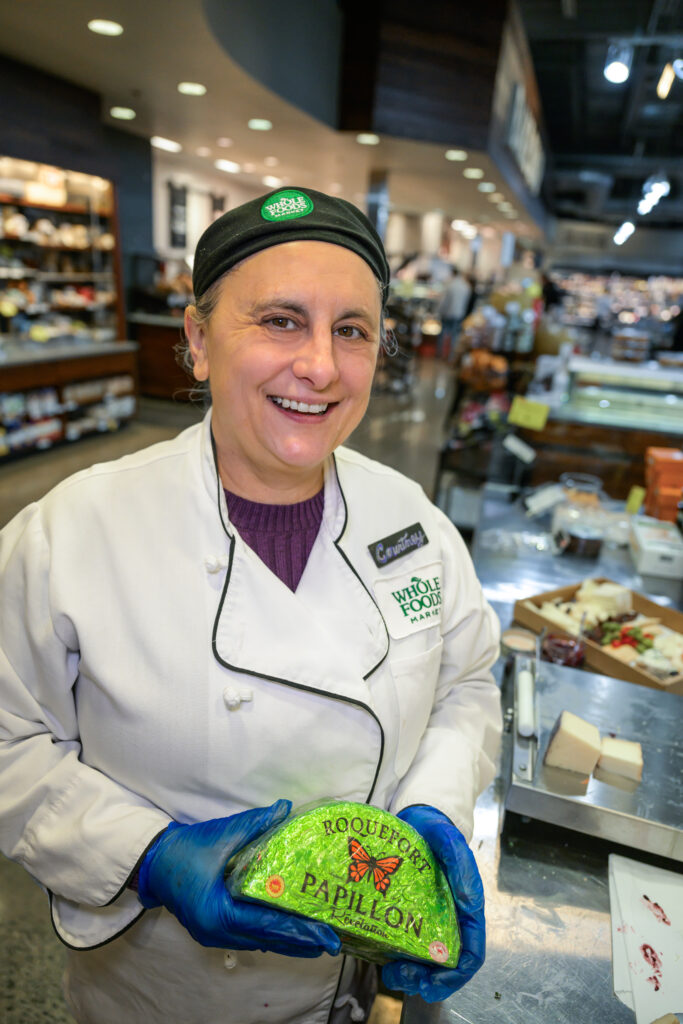
THE CHEESEMONGER
By Chris Wadsworth
Courtney Owens had a career trajectory not dissimilar with that of many Ashburn parents. She worked various jobs in her younger years – including a stint in the U.S. Navy. Then after she married her husband, Dave, and children came around, she was a busy stay-at-home mom for many years, volunteering in her kids’ schools and with local Boy Scouts and Girl Scouts.
Fast forward to when the kids – David, 19, and Samantha, 18 – started flying the nest and it was time for Owens to ask herself, “What’s next?”

The answer – which surprised even her – was cheese.
In 2023, Owens – who lives in Ashburn’s Broadlands neighborhood – took a part-time job at Whole Foods in the Belmont Chase shopping center. She was initially filling online grocery orders, but one day, the cheese department needed somebody to help out. It would change her life.
“I worked in that department for a day, and I was just like, ‘Oh I love cheese, and I love learning about it,’” said Owens, who soon joined the department as a cheese seller.
Ashburn Magazine spoke with Owens about how she became interested in cheese and what she has learned about herself and about cheese since taking on this new role. Here are excerpts from our conversation.
Q: Where did this interest in cheese come from? Was it always there or is this something new in your life?
“I would say it probably happened at Clyde’s.”
Q: Clyde’s Willow Creek Farm, the restaurant in Ashburn?
“Yep. I had a friend visit me from Canada. And we went to Clyde’s, and we ordered the cheese. You know the platter that they have there – and it was amazing. We were sitting around the table, and it was like the lights went off. I was like, ‘This is so delicious.’”
Q: So, you weren’t into cheeses when you were younger?
“As a kid, I was the typical – ‘I only want to eat pizza.’ But at some point in my early adulthood, especially when I lived in Italy [in the Navy], I started to try other things, and it opened up my palate. I realized that maybe I wouldn’t love everything, but I’d be willing to try anything.”
Q: Was it daunting learning about cheeses on the job?
“People come into the store and they’re afraid of our back wall of freshly cut cheese. Instead, they gravitate towards the pre-packaged things because they feel like they don’t know enough about the cheese on the back wall. And I was in exactly that same position when I started that job. I wanted to buy that cheese, but I knew hardly anything.”
Q: So how did you learn the ins and outs of selling cheese?
“There was a young lady who started at the exact same time as me and I said to her, ‘I want to be able to sell cheese, but I can’t sell cheese unless I know what it tastes like – so I have this idea of what we can do together. Let’s start at one side of the cheese wall and try to make our way across the wall within a year and then let’s make a cheese book for ourselves with the information that we gather.”
Q: And the cheese book worked?
“Eventually, we no longer needed to write it in the book because you just naturally remember it, but we worked our way through all the cheeses.”
Q: When we first heard about your job, we immediately thought how cool to be a cheesemonger. That was a title you weren’t comfortable with initially.
“The team leader referred to me as a cheesemonger and she’s a cheese professional – who has the accreditation and has taken all the tests – and I was like, ‘I’m not a cheese professional,’ and she said, ‘Well, technically you are.’ And I looked up the description of cheesemonger and I was like, ‘Oh, my goodness. I really am a cheese professional.’”
Q: And what is the definition of a cheesemonger?
“The cheesemonger is the person who is the cheese sales person, who knows about the seasonal cheeses, who can help a customer choose the right cheese, and that is 100% spot-on what I am.”
Q: And now you’re happy to call yourself a cheesemonger.
“You still hesitate to label yourself that way, but I had a customer who walked away from my counter and turned to her husband and said, ‘That was the best shopping experience I’ve ever had. So much fun.’ So, when my [team leader] called me a cheesemonger – I was like why am I so afraid of being proud of what I’ve learned.”
Q: Working with cheese sounds like a dream job to many folks. What’s a typical day like?
“Well, we do temperature runs all day long to make sure that all the cheeses are kept at the proper temperatures. I have to stock items all day long and then, in addition to that, I’m literally cutting the cheese all day long – no pun intended.”
Q: Cutting cheeses every day is a big part of your job.
“Definitely. The parmesan in particular. It takes the most time to cut – a full shift from beginning to end.”
Q: Why so?
“You start off with this huge round of cheese and it needs to be brought to room temperature so you can actually cut it. You have tools you use to score it. Then there’s basically a tool that looks a little bit like a short sword and you have to sink it into the cheese along the score to make a break line and then you use the tools to just break it apart naturally. Then it’s just cutting and cutting and cutting again and breaking it down into the pieces and then wrapping the pieces, pricing them and then taking the rinds and cutting those down as well and packaging them because the rinds can be used to flavor soup.”
Q: After a career in the Navy and as a busy wife and mom and volunteer, what is it about this latest reinvention of yourself that you find so rewarding?
“I just love the part where I am working with the customer – when they have that lightbulb moment – ‘Yes, this is the cheese that I want.’ I have customers that come in and say, ‘I was in France, and I had this cheese, and I sure wish I had written down the name of it.’ So, it’s like an investigation, right? So, I say let’s figure this out. We know it’s a French cheese. What did it taste like? What color was it? What was the texture like?”
Q: And then you and the customer try samples, right? You’re big on sampling.
“At Whole Foods, they like to say we ‘delight the customer’ and that’s a little corny, but it’s totally true. They want you to make the customer happy so sometimes I’ll pull three cheeses and I’ll be like, ‘Do you like this? Or how about this? Or this?’ And then we work from there. Without a doubt, that is my favorite part of the job and what makes it worth going back every day.”
FIVE FAVORITES
We asked Courtney Owens, a cheesemonger at Whole Foods in Ashburn, to suggest five of her favorite cheeses for readers to explore.
Hervé Mons Brebis Pyrénées (French). Hard sheep’s milk cheese from the Pyrénées Mountains in France. Aged just six months and has a slightly floral, sweet and nutty flavor. Pair with fruit and nuts.
Saint Angel Triple Cream Brie (French), Triple cream cow milk brie. Has a fluffy, white rind and creamy interior. Tastes of sweet cream and whipped butter. Pairs well with raspberry or fig jam.
Central Formagio Moliterno Al Tartufo (Italian). Semi-soft sheep milk cheese from Sardinia. Truffles are infused into the cheese after it has aged, giving it a marbleized appearance. Rich, earthy, flavor that pairs well with red wine.
Sartori Merlot BellaVitano (American/Wisconsin). Hard cow milk cheese with a bold nutty, plum, berry and wine flavor. The rind is purple in color and meant to be eaten. Pair with nuts, crackers or dried meats.
Papillon Révélation Roquefort (French). Soft sheep milk blue cheese aged in the Combalou caves of the Roquefort-sur-Soulzon region. Tangy, creamy and slightly acidic with beautiful blue veining. The exterior is edible and slightly salty. Pair with Primo Blackberry Serrano Jam.
Bonus Recommendation: For the kids or anyone with a sweet tooth, try Ski Queen Gjetost (Norwegian). A light brown, semi-hard cheese, made from a blend of cow and goat milk. It has a delicious, slightly sweet caramel taste. Slice thinly and serve with apples or pears, dessert foods or add to fondu.


